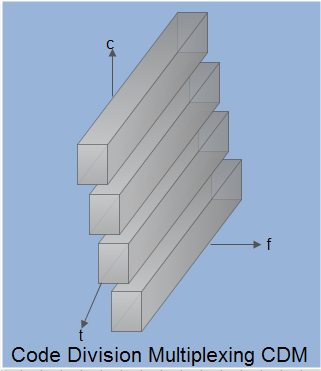CDM is widely used in so-called second-generation (2G) and third-generation 3G wireless communications. The technology is used in ultra-high-frequency (UHF) cellular telephone systems in the 800-MHz and 1.9-GHz bands. This is a combination of analog-to-digital conversion and spread spectrum technology.
CDM may be defined as a form of multiplexing where the transmitter encodes the signal using a pseudo-random sequence. CDM involves the original digital signal with a spreading code. This spreading has the effect of spreading the spectrum of the signal greatly and reducing the power over anyone part of the spectrum. On the other hand, the receiver knows about the code generated and transmitted by the transmitter and therefore, can decode the received signal. Each different random sequence corresponds to a different communication channel from multiple stations.
Code Division Multiplexing assigns each channel its own code to make them separate from each other. These unique underlying codes, which ~hen decoded restore’ the original desired signal while totally removing the effect of the other coded channels. Guard spaces are realized by using codes with orthogonal codes. In cue of TDM and FDM, channels are isolated by separate .time or frequency slots, which are occupied in common by all users.
Figure explains how all channels Ci, use the same frequency at the same time for transmission.

It may be understood that a single bit may be transmitted by modulating a series of signal elements at different frequencies in some particular order. These numbers of different frequencies per bit are called as the chip rate. If one or more bits are transmitted at the same frequency, it is called as frequency hopping. This will happen only when the chip rate ,is less than one because chip rate is the ratio of frequency and bit. At the receiving side, receiver decodes a 0 or a 1 bit by checking these frequencies in the correct order.
A disadvantage of CDM is that each user’s transmitted bandwidth is enlarged than the digital data rate of the source. The result is an occupied bandwidth approximately equal to the coded rate. Therefore, CDM and spread spectrum are used interchangeably. The transmitter and receiver require a complex electronics circuitry.
The main advantage of CDM is protection from interference and tapping because only the sender the receiver knows the spreading code.
 Dinesh Thakur holds an B.C.A, MCDBA, MCSD certifications. Dinesh authors the hugely popular
Dinesh Thakur holds an B.C.A, MCDBA, MCSD certifications. Dinesh authors the hugely popular